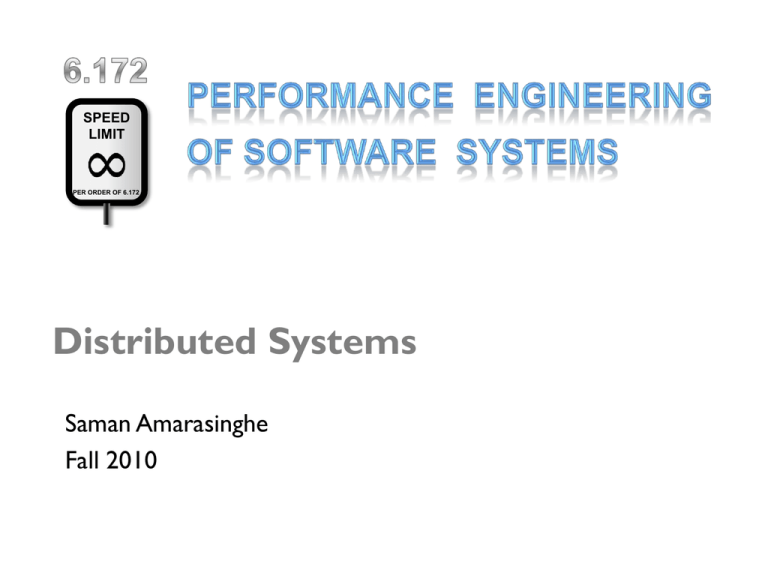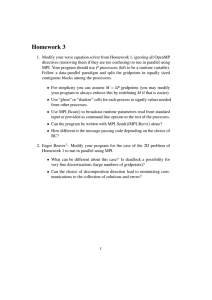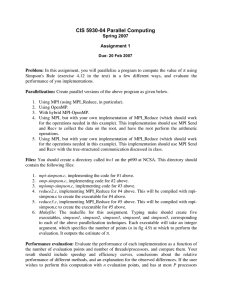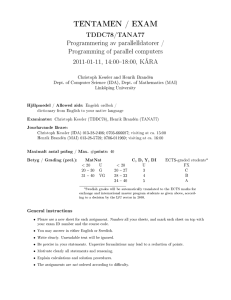
SPEED
LIMIT
PER ORDER OF 6.172
Distributed Systems
Saman Amarasinghe
Fall 2010
Final Project
Design review with your Masters
Competition on Dec 9th
Akamai Prize for the winning team
Celebration / demonstration at Akamai HQ
iPOD nano for each team member!
© Saman Amarasinghe 2008
5
Scaling Up
Cluster Scale
Data Center Scale
Planet Scale
7
Cluster Scale
Running your program in Multiple Machines
Why?
Parallelism Higher Throughput and Latency
Robustness No single point of failure
Cost savings Multiple PCs are lot cheaper than a mainframe
Programming Issues
Parallel programming with message passing
Robustness tolerating failure
© Saman Amarasinghe 2008
9
Shared vs. Distributed Memory
NIC
Core
Core
Core
Core
L1$
L1$
L1$
L1$
L2$
Core
Core
Core
Core
L1$
L1$
L1$
L1$
L2$
Memory
NIC
L2$
L2$
Memory
Memory
Memory Layer
Access Time (cycles)
Relative
Register
1
1
Cache
1–10
10
DRAM Memory
1000
100
Remote Memory (with MPI)
10000
10
© Saman Amarasinghe 2008
Shared Memory vs. Message Passing
Shared Memory
All Communication via. Memory
Synchronization via. Locks
• Locks get translated into memory actions
Message Passing
Communication via. explicit messages
Synchronization via. synchronous messages
© Saman Amarasinghe 2008
10
Orion 4x4 Send/Recv Times
Courtesy of Duncan Grove. Used with permission.
From a slide by Duncan Grove @ Adelaide University7
12
Anatomy of a message
Application
Application
OS
OS
NIC
NIC
Network Hardware
Network Hardware
© Saman Amarasinghe 2008
Non-Buffered Blocking
Message Passing Operations
16
© Addison-Wesley. All rights reserved. This content is excluded from our Creative
Commons license. For more information, see http://ocw.mit.edu/fairuse.
When sender and receiver do not reach communication
point at similar times, there can be considerable idling
overheads.
``Introduction to Parallel Computing'', Addison Wesley, 2003
Buffered Blocking
Message Passing Operations
18
© Addison-Wesley. All rights reserved. This content is excluded from our Creative
Commons license. For more information, see http://ocw.mit.edu/fairuse.
Blocking buffered transfer protocols:
(a) in the presence of communication hardware with buffers at send and
receive ends
(b) in the absence of communication hardware, sender interrupts receiver
and deposits data in buffer at receiver end.
``Introduction to Parallel Computing'', Addison Wesley, 2003
Non-Blocking
Message Passing Operations
20
© Addison-Wesley. All rights reserved. This content is excluded from our Creative
Commons license. For more information, see http://ocw.mit.edu/fairuse.
Non-blocking non-buffered send and receive operations
(a) in absence of communication hardware;
(b) in presence of communication hardware.
``Introduction to Parallel Computing'', Addison Wesley, 2003
22
MPI Language
Emerging standard language for cluster programming
Machine independent portable
Features
Each machine has a process
• Its own thread of control
• Its own memory
Each process communicate via messages
• Data that need to be communicated will get packaged into a message
and sent
• Addresses in each process may be different
– Cannot communicate pointers
© Saman Amarasinghe 2008
23
#include "mpi.h"
#include <stdio.h>
int main(int argc, char * argv[])
{
int numtasks, myid, dest, source, rc, count, tag=1;
char inmsg, outmsg='x';
MPI_Status Stat;
MPI_Init(&argc,&argv);
MPI_Comm_size(MPI_COMM_WORLD, &numtasks);
MPI_Comm_rank(MPI_COMM_WORLD, &myid);
if (myid== 0) {
dest = 1;
source = 1;
rc = MPI_Send(&outmsg, 1, MPI_CHAR, dest, tag, MPI_COMM_WORLD);
rc = MPI_Recv(&inmsg, 1, MPI_CHAR, source, tag, MPI_COMM_WORLD, &Stat);
} else if (myid== 1) {
dest = 0;
source = 0;
rc = MPI_Recv(&inmsg, 1, MPI_CHAR, source, tag, MPI_COMM_WORLD, &Stat);
rc = MPI_Send(&outmsg, 1, MPI_CHAR, dest, tag, MPI_COMM_WORLD);
}
rc = MPI_Get_count(&Stat, MPI_CHAR, &count);
MPI_Finalize();
Courtesy of Lawrence Livermore National Laboratory. Used with permission.
}
© Saman Amarasinghe 2008
From llnl.gov website
25
#include "mpi.h"
#include <stdio.h>
int main(int argc, char * argv[])
{
int numtasks, myid, next, prev, buf[2], tag1=1, tag2=2;
MPI_Request recv_reqs[2], send_reqs[2];
MPI_Status stats[4];
MPI_Init(&argc,&argv);
MPI_Comm_size(MPI_COMM_WORLD, &numtasks);
MPI_Comm_rank(MPI_COMM_WORLD, &myid);
prev = (myid-1)%numtasks;
next = (myid+1)%numtasks;
MPI_Irecv(&buf[0], 1, MPI_INT, prev, tag1, MPI_COMM_WORLD, &recv_reqs[0]);
MPI_Irecv(&buf[1], 1, MPI_INT, next, tag2, MPI_COMM_WORLD, &recv_reqs[1]);
MPI_Isend(&rank, 1, MPI_INT, prev, tag2, MPI_COMM_WORLD, &send_reqs[0]);
MPI_Isend(&rank, 1, MPI_INT, next, tag1, MPI_COMM_WORLD, &send_reqs[1]);
MPI_Waitall(2, recv_reqs, stats);
{ do some work }
MPI_Waitall(2, send_reqs, stats);
MPI_Finalize();
}
Courtesy of Lawrence Livermore National Laboratory. Used with permission.
© Saman Amarasinghe 2008
From llnl.gov website
27
Example: PI in C -1
#include "mpi.h"
#include <math.h>
int main(int argc, char *argv[])
{
int done = 0, n, myid, numprocs, i, rc;
double PI25DT = 3.141592653589793238462643;
double mypi, pi, h, sum, x, a;
MPI_Init(&argc,&argv);
MPI_Comm_size(MPI_COMM_WORLD,&numprocs);
MPI_Comm_rank(MPI_COMM_WORLD,&myid);
while (!done) {
if (myid == 0) {
printf("Enter the number of intervals: (0 quits) ");
scanf("%d",&n);
}
MPI_Bcast(&n, 1, MPI_INT, 0, MPI_COMM_WORLD);
if (n == 0) break;
Courtesy of William Gropp. Used with permission.
15
Intro to MPI by William Gropp & Ewing Lusk, ANL
28
Example: PI in C - 2
h
= 1.0 / (double) n;
sum = 0.0;
for (i = myid + 1; i <= n; i += numprocs) {
x = h * ((double)i - 0.5);
sum += 4.0 / (1.0 + x*x);
}
mypi = h * sum;
MPI_Reduce(&mypi, &pi, 1, MPI_DOUBLE, MPI_SUM, 0,
MPI_COMM_WORLD);
if (myid == 0)
printf("pi is approximately %.16f, Error is %.16f\n",
pi, fabs(pi - PI25DT));
}
MPI_Finalize();
return 0;
}
16
Courtesy of William Gropp. Used with permission.
Intro to MPI by William Gropp & Ewing Lusk, ANL
Correctness Issues
Deadlocks
Blocking send/receives can lead to deadlocks
Exhaustion of resources can also lead to deadlocks (next slides)
Stale data
Need to make sure that up-to-date information is communicated
Robustness
Single box is very reliable. And when fails it is catastrophic
A cluster has a lot more failures
• But you have a chance of making a program more robust
© Saman Amarasinghe 2008
30
31
Sources of Deadlocks
Send a large message from process 0 to process 1
If there is insufficient storage at the destination, the send must wait for
the user to provide the memory space (through a receive)
What happens with
•
Process 0
Process 1
Send(1)
Recv(1)
Send(0)
Recv(0)
This is called “unsafe” because it depends on the availability of
system buffers
Courtesy of William Gropp. Used with permission.
18
Intro to MPI by William Gropp & Ewing Lusk, ANL
Some Solutions to the “unsafe”
Problem
Order the operations more carefully:
•
Process 0
Process 1
Send(1)
Recv(1)
Recv(0)
Send(0)
Use non-blocking operations:
Process 0
Process 1
Isend(1)
Irecv(1)
Waitall
Isend(0)
Irecv(0)
Waitall
Courtesy of William Gropp. Used with permission.
19
Intro to MPI by William Gropp & Ewing Lusk, ANL
Performance Issues
Occupancy Costs
Latency Tolerance
Network Bottleneck
© Saman Amarasinghe 2008
32
Occupancy Cost
Each message is expensive
Context switch, buffer copy, network protocol stack processing at the
sender
NIC to OS interrupt and buffer copy, OS to application signal and context
switch and buffer copy at the receiver
Message setup overhead is high
Send small amount of large messages
© Saman Amarasinghe 2008
32
Latency Tolerance
Communication is slow
Memory systems have 100+ to 1 latency to CPU
Cluster interconnects have 10,000+ to 1 latency to CPU
Grid interconnects have 10,000,000+ to 1 latency to CPU
Split operations into a separate initiation and
completion step
Programmers rarely good at writing programs with split operations
33
Latency Tolerance in MPI
Example: Point-to-point “Rendezvous”
Typical 3-way:
• Sender requests
• Receiver acks with ok to send
• Sender delivers data
Alternative: “Receiver requests” 2-way
• Receiver sends “request to receive” to designated sender
• Sender delivers data
• MPI_ANY_SOURCE receives interfere
MPI RMA: sender delivers data to previously agreed location
34
Network Bottlenecks
Network Storms
Bursty behavior can clog the networks
• TCP timeouts can be very expensive
Trying to stuff too much data can lead to big slowdowns
• Too much data enters a overloaded switch/router/computer
• A packet gets dropped
• Waits for the packet until timeout
• TCP backoff kicks in adds a big delay
Messages are not streams
User buffer can be sent in any order
Allows aggressive (but good-citizen) UDP based communication
• Aggregate acks/nacks
• Compare to “Infinite Window” TCP (receive buffer)
80%+ of bandwidth achievable on long-haul system
• Contention management can maintain “good Internet behavior”
• Actually reduces network load by reducing the number of acks and retransmits;
makes better use of network bandwidth (use it or lose it)
35
Data Center Scale
Some programs need to scale-up
A lot of users
A lot of data
A lot of processing
© Saman Amarasinghe 2008
37
Examples of Need to Scale
Airline Reservation System
Stock Trading System
Web Page Analysis
Scene Completion
Web Search
37
Example: Web Page Analysis
38
Fetterly, Manasse, Najork, Wiener (Microsoft, HP),
“A Large-Scale Study of the Evolution of Web
Pages,” Software-Practice & Experience, 2004
© John Wiley & Sons. All rights reserved. This content is excluded from our
Creative Commons license. For more information, see http://ocw.mit.edu/fairuse.
Experiment
Use web crawler to gather 151M HTML pages weekly 11 times
• Generated 1.2 TB log information
Analyze page statistics and change frequencies
Slide courtesy of Randal Bryant. Used with permission.
From: www.cs.cmu.edu/~bryant/presentations/DISC-FCRC07.ppt
Example: Scene Completion
39
Images courtesy of James Hays and Alexei Efros. Used with permission.
Hays, Efros (CMU), “Scene Completion Using
Millions of Photographs” SIGGRAPH, 2007
Image Database Grouped by
Semantic Content
Computation
Index images offline
50 min. scene matching, 20 min. local
matching, 4 min. compositing
Reduces to 5 minutes total by using 5
machines
30 different Flickr.com groups
2.3 M images total (396 GB).
Select Candidate Images Most
Suitable for Filling Hole
Classify images with gist scene detector
[Torralba]
Color similarity
Local context matching
Extension
Flickr.com has over 500 million images …
Slide courtesy of Randal Bryant. Used with permission.
From: www.cs.cmu.edu/~bryant/presentations/DISC-FCRC07.ppt
40
Example: Web Search
2000+ processors participate in a single query
200+ terabyte database
1010 total clock cycles
0.1 second response time
5¢ average advertising revenue
Slide courtesy of Randal Bryant. Used with permission.
From: www.cs.cmu.edu/~bryant/presentations/DISC-FCRC07.ppt
Google’s Computing Infrastructure
41
System
~ 3 million processors in clusters of ~2000 processors each
Commodity parts
• x86 processors, IDE disks, Ethernet communications
• Gain reliability through redundancy & software management
Partitioned workload
• Data: Web pages, indices distributed across processors
• Function: crawling, index generation, index search, document retrieval,
Ad placement
Barroso, Dean, Hölzle, “Web Search for a Planet:
The Google Cluster Architecture” IEEE Micro 2003
Similar systems at Microsoft & Yahoo
Slide courtesy of Randal Bryant. Used with permission.
From: www.cs.cmu.edu/~bryant/presentations/DISC-FCRC07.ppt
42
Google’s Programming Model
MapReduce
k1
k1
Reduce
kr
Key-Value
Pairs
M
M
M
M
x1
x2
x3
xn
Map
Map computation across many objects
• E.g., 1010 Internet web pages
Aggregate results in many different ways
System deals with issues of resource allocation & reliability
Dean & Ghemawat: “MapReduce: Simplified Data
Processing on Large Clusters”, OSDI 2004
Programming Model
43
Borrows from functional programming
Users implement interface of two functions:
map
(in_key, in_value) ->
(out_key, intermediate_value) list
reduce (out_key, intermediate_value list) ->
out_value list
Courtesy of Tsinghua University and Google. Used with permission.
From: Mass Data Processing Technology on Large
Scale Clusters Summer, 2007, Tsinghua University
32
44
map
Records from the data source
(lines out of files, rows of a database, etc) are fed
into the map function as key-value pairs: e.g.,
<filename, line>.
map() produces
one or more intermediate values
along with an output key from the input.
Courtesy of Tsinghua University and Google. Used with permission.
From: Mass Data Processing Technology on Large
Scale Clusters Summer, 2007, Tsinghua University
33
45
reduce
Combine data
After the map phase is over,
all the intermediate values for a given output key are
combined together into a list
reduce() combines those intermediate values into
one or more final values for that same output key
(in practice, usually only one final value per key)
Courtesy of Tsinghua University and Google. Used with permission.
From: Mass Data Processing Technology on Large
Scale Clusters Summer, 2007, Tsinghua University
34
46
Architecture
Input key*value
pairs
Input key*value
pairs
...
map
Data store 1
(key 1,
values...)
(key 2,
values...)
map
Data store n
(key 3,
values...)
(key 2,
values...)
(key 1,
values...)
(key 3,
values...)
== Barrier == : Aggregates intermediate values by output key
key 1,
intermediate
values
reduce
final key 1
values
key 2,
intermediate
values
reduce
final key 2
values
key 3,
intermediate
values
reduce
final key 3
values
Courtesy of Tsinghua University and Google. Used with permission.
From: Mass Data Processing Technology on Large
Scale Clusters Summer, 2007, Tsinghua University
35
46
Parallelism
map() functions
run in parallel, creating different intermediate values from
different input data sets
reduce() functions
also run in parallel, each working on a different output key
All values are processed independently
Bottleneck:
reduce phase can’t start until map phase is completely
finished.
Courtesy of Tsinghua University and Google. Used with permission.
From: Mass Data Processing Technology on Large
Scale Clusters Summer, 2007, Tsinghua University
36
Example: Count word
occurrences
47
map(String input_key, String input_value):
// input_key: document name
// input_value: document contents
for each word w in input_value:
EmitIntermediate(w, "1");
reduce(String output_key, Iterator intermediate_values):
// output_key: a word
// output_values: a list of counts
int result = 0;
for each v in intermediate_values:
result += ParseInt(v);
Emit(AsString(result));
Courtesy of Tsinghua University and Google. Used with permission.
From: Mass Data Processing Technology on Large
Scale Clusters Summer, 2007, Tsinghua University
37
48
How to Scale?
Distribute
Parallelize
Distribute data
Approximate
Get to a sufficiently close answer, not the exact
A little stale data might be sufficient
Transact
If exactness is required, use transactions
© Saman Amarasinghe 2008
48
Planet Scale
Some programs need to scale-up
A lot of users
A lot of data
A lot of processing
Examples:
Seti@Home
Napster
BitTorrent
© Saman Amarasinghe 2008
Scaling Planet Wide
Truly Distributed
No global operations
No single bottleneck
Distributed view stale data
Adaptive load distribution is a must
© Saman Amarasinghe 2008
49
Case Study – The Bonsai System
Case study from VMware Inc.
A Prototype for “Deduplication” at Global Scale
Why? For Moving Virtual Machines Across the World
© Saman Amarasinghe 2008
What is the Virtualization Revolution
Decouple the “machine” from the physical machine and make it a
file
Virtual Machines can be..
Replicated
Moved
Played
© Source unknown. All rights reserved. This content is excluded from our Creative
Commons license. For more information, see http://ocw.mit.edu/fairuse.
What is the Virtualization Revolution
Decouple the “machine” from the physical machine and make it a
file
Virtual Machines can be..
Replicated
Moved
Played
Stored
© Source unknown. All rights reserved. This content is excluded from our Creative
Commons license. For more information, see http://ocw.mit.edu/fairuse.
Cloud Computing
Vision: Global marketplace of computing power
Work migrates as needed
To find more computing resources
To be near data and/or users
To find a cheaper provider of resources
To amortize the risk of catastrophic failure
Issues
Mostly applications are encapsulated
as virtual machines
They are hefty to move
© Saman Amarasinghe 2008
Time to Move a VM Disk file
Fedora 9
Windows
2000
Windows server w/
SQL
2000 server
A typical Boston desktop to Palo Alto desktop (2mbps network bandwidth) copying of a VM file
Fast Compression (Zip, default)
No compression
Bonsai
High compression (p7zip)
Fast Compression (Zip, default)
Ubuntu 7.10 Ubuntu 8.04
No compression
Bonsai
High compression (p7zip)
Fast Compression (Zip, default)
No compression
0
500
Compression
1000
Transmission
1500
2000
Decompression
2500
3000
3500
Time to Move a VM Disk file
Fedora 9
Windows
2000
Windows server w/
SQL
2000 server
A typical Boston desktop to Palo Alto desktop (2mbps network bandwidth) copying of a VM file
Fast Compression (Zip, default)
No compression
Bonsai
High compression (p7zip)
Fast Compression (Zip, default)
Ubuntu 7.10 Ubuntu 8.04
No compression
Bonsai
High compression (p7zip)
Fast Compression (Zip, default)
No compression
0
500
Compression
1000
Transmission
1500
2000
Decompression
2500
3000
3500
Data Redundancy – A Key Observation
Observation 1: Large part of each VMDK is executables
Observation 2: A few applications dominate the world and are in
every machine (eg: XP and Office on desktops)
Observation 3: Substantial redundancy even within a single disk
(eg: DLL cache, install and repair info)
Observation 4: Many Disks have a lot of zero blocks!
# of 4K blocks
12,000,000
10,000,000
100
# nonzero blocks
90
# unique blocks
% Unique blocks
14,000,000
8,000,000
6,000,000
4,000,000
2,000,000
0
1
2
3
4
5
# of VMs
6
7
8
9
80
70
60
50
40
30
20
10
0
1
2
3
4 5 6 7
# of VMs
8
9
Basic De-Duplication
A lot of data redundancy
A
A
A
B
B
C
A
C
A
C
D
B
B
A
A
D
D
B
Basic De-Duplication
A lot of data redundancy
Break them into blocks
A
A
A
Eg: 4K byte disk blocks
B
B
C
A
C
A
C
D
B
B
A
A
D
D
B
Basic De-Duplication
A lot of data redundancy
Break them into blocks
A
A
A
B
B
C
Calculate a hash value per
block
ab
ab
ac
A
C
A
Eg: SHA-256 hash (32 bytes)
C
D
B
ac
cd
ab
B
A
A
D
D
B
bd
ad
ab
Eg: 4K byte disk blocks
Basic De-Duplication
A lot of data redundancy
Break them into blocks
A
A
A
B
B
C
Calculate a hash value per
block
ab
ab
ac
A
C
A
Eg: SHA-256 hash (32 bytes)
C
D
B
Identify similar blocks by
comparing the hash values
ac
cd
ab
B
A
A
D
D
B
bd
ad
ab
Eg: 4K byte disk blocks
Basic De-Duplication
A lot of data redundancy
Break them into blocks
A
A
A
B
B
C
Calculate a hash value per
block
ab
ab
ac
A
C
A
Eg: SHA-256 hash (32 bytes)
C
D
B
Identify similar blocks by
comparing the hash values
Eliminate copies and keep only
the hash as an index
ac
cd
ab
B
A
A
D
D
B
bd
ad
ab
Eg: 4K byte disk blocks
Basic De-Duplication
A lot of data redundancy
Break them into blocks
Eg: 4K byte disk blocks
Calculate a hash value per
block
Recipe
A
A
B
C
ab
ac
Common C
Block Store
D
Eg: SHA-256 hash (32 bytes)
Identify similar blocks by
comparing the hash values
Eliminate copies and keep only
the hash as an index
Much more compact storage
ab
ac
cd
B
A
D
D
bd
ad
Recipe table and common block store can be separated
ab
ab
Inter. vs. Intra. Deduplication
Recipe and Common Block Store in same
“system” Traditional deduplication
Multiple Recipes for One Common Block Store
Pro: Single copy of common data blocks
across systems Higher compression
Cons: Lack of universal mobility
Cons: Inability to guarantee data availability
Cons: Inability to guarantee data integrity
Who owns and manages the Common Block Store?
Bonsai: A Global Store for Common Disk Blocks
Take Advantage of the Monoculture
Store the common blocks in a global store
“Google” or “Akamai” or “VeriSign” for disk blocks
Bonsai Flow
Hash key
Hash 1
Encryption
Compression
Hash 2
Private
key
?
UID
UID
Priv. key
Same original block from all the systems will have the identical encrypted block
Gets deduplicated
No one can read the content of the block unless the original block was seen at one
time
Requires the hash key to read the text
Requires the original block to calculate the hash key
Search by UID No possibility of getting the wrong block due to a hash collision
Bonsai Flow
Hash key
Hash 1
Encryption
Compression
Hash 2
UID
UID
Private
key
Priv. key
Decryption
UID
Priv key
UID
Decompression
Hash Key vs UID
Hash Key
Unique ID
Reliability
Hash check is inexpensive
1 in 18,446,744,073,709,600,000 (264)
chances that a different block will match
the hash key
Optional hash check + full page check
Lookup is random costly
UID layout has good special locality
• Full page check can be done later
• No errors possible in a match
Efficiency
Integrity
Can be a P2P system
Central/global authority to assign UIDs
• Guarantee block integrity and availability
Centos Fedore
Red hat
Suse
Ubuntu
Windows NT
Windows 2000
windows 2003
Windows XP
Vmstore at Cambridge
Base Vms grabbed from Exit 118
Base Vms grabbed from Exit 117
Virtual Appliances base VM.
Vmstore at Cambridge
Virtual Appliances VM with Application
Determina Vms
Vmstore at Cambridge
Base Vms grabbed from Exit 116
Base Vms grabbed from Exit 115
Determina Vms
Determina Vms
Determina Vms
Vmstore at Cambridge
Determina Vms
Determina Vms
Determina Vms
Determina Vms
Vmstore at Cambridge
Determina Vms
Determina Vms
Virtual Appliances base VM.
Virtual Appliances VM with Application
Virtual Appliances VM with Application
Virtual Appliances base VM.
Virtual Appliances VM with Application
Vmstore at Cambridge
Determina Vms
Vmstore at Cambridge
Virtual Appliances VM with Application
P2V
Virtual Appliances VM with Application
Compression Ratios
100%
90%
80%
70%
60%
50%
40%
30%
20%
10%
0%
End-to-End Time to Move a VMDK
Fedora 9
Windows
2000
Windows server w/
SQL
2000 server
A typical Boston desktop to Palo Alto desktop (2mbps network bandwidth) copying of a VMDK
Fast Compression (Zip, default)
No compression
Bonsai
High compression (p7zip)
Fast Compression (Zip, default)
Ubuntu 7.10 Ubuntu 8.04
No compression
Bonsai
High compression (p7zip)
Fast Compression (Zip, default)
No compression
0
500
Compression
1000
Transmission
1500
2000
Decompression
2500
3000
3500
Different Levels of Compression
12,000,000,000
Total Bytes
10,000,000,000
8,000,000,000
6,000,000,000
4,000,000,000
2,000,000,000
0
Total Size of VM
plus compressing
blocks
plus local
deduplication
plus global store
Contribution of Each Component to Compression
100%
90%
80%
70%
% of Blocks
60%
Server Hits
50%
Duplicates Hit at the server
40%
Local Dedup Blocks
Zero Block
30%
Compressed Blocks
20%
10%
0%
Ubuntu 7.10
Ubuntu 8.04
Fedorra core 9 with
512MB
Windows 2000
server Has SQL
Server and Sygate
installed.
Windows 2000
server
Contribution of Each Component to Compression
100%
90%
80%
70%
% of Blocks
60%
Server Hits
50%
Duplicates Hit at the server
40%
Local Dedup Blocks
Zero Block
30%
Compressed Blocks
20%
10%
0%
Ubuntu 7.10
Ubuntu 8.04
Fedorra core 9 with
512MB
Windows 2000
server Has SQL
Server and Sygate
installed.
Windows 2000
server
Size of the compressed blocks > 99% of the size of the Bonsai VMDK
Technical Challenges
Adaptive Store
Robust and Scalable Truly-Global Store
Integration with the Product Line
Improve the Compression Rate
Security and Privacy
MIT OpenCourseWare
http://ocw.mit.edu
6.172 Performance Engineering of Software Systems
Fall 2010
For information about citing these materials or our Terms of Use, visit: http://ocw.mit.edu/terms.





